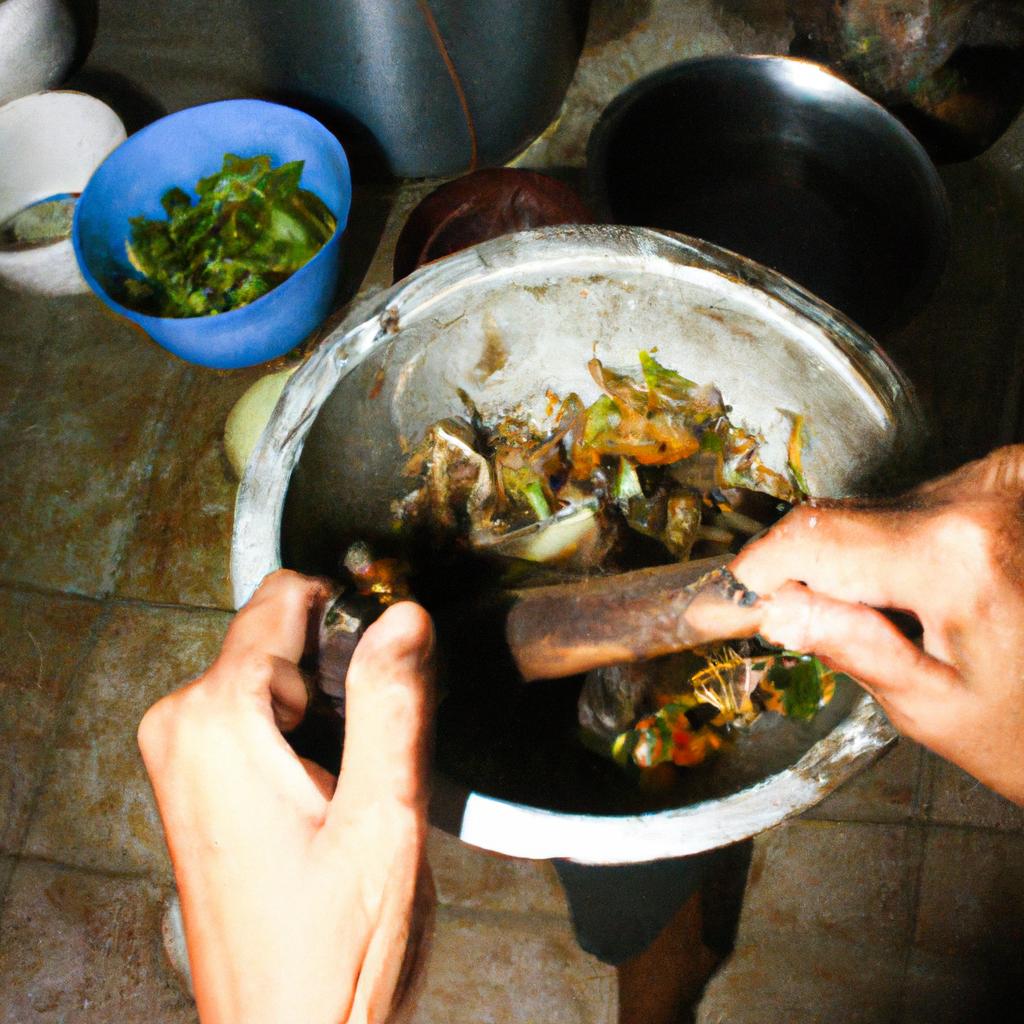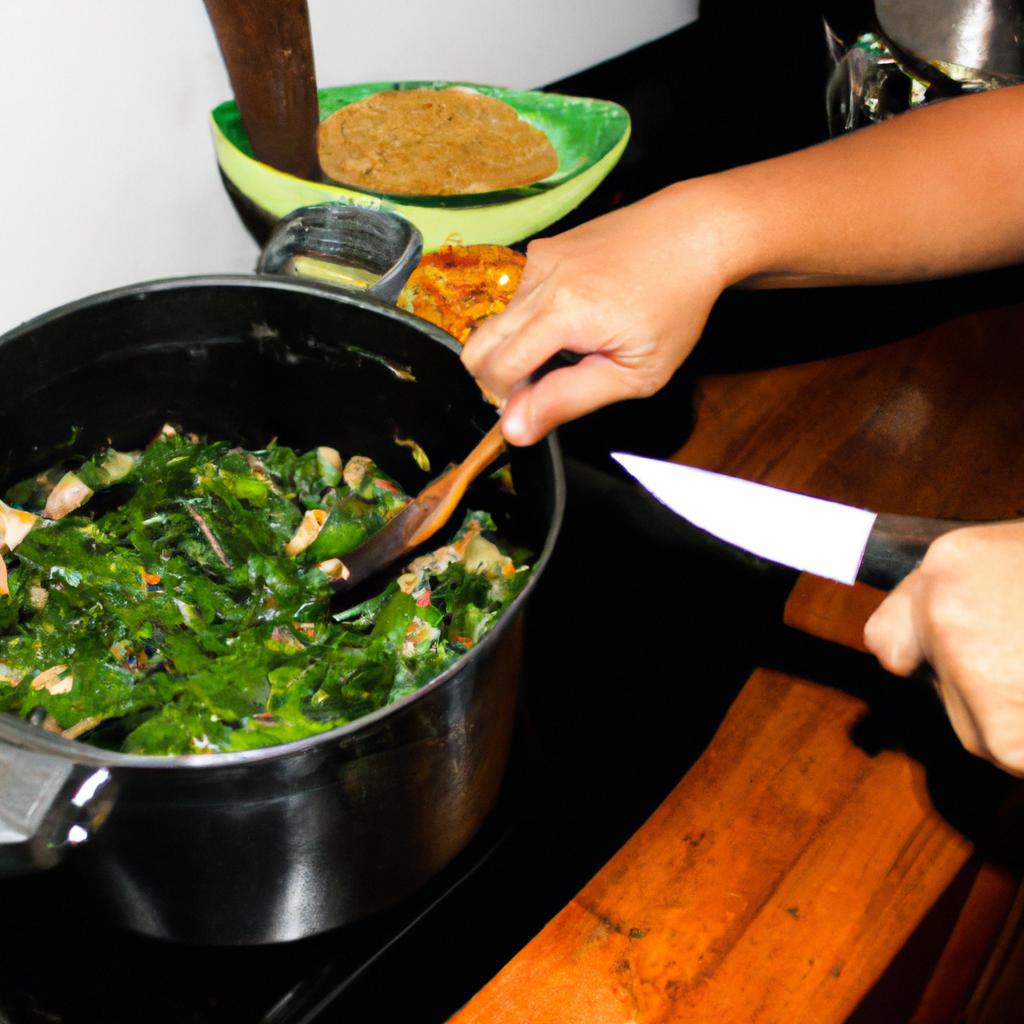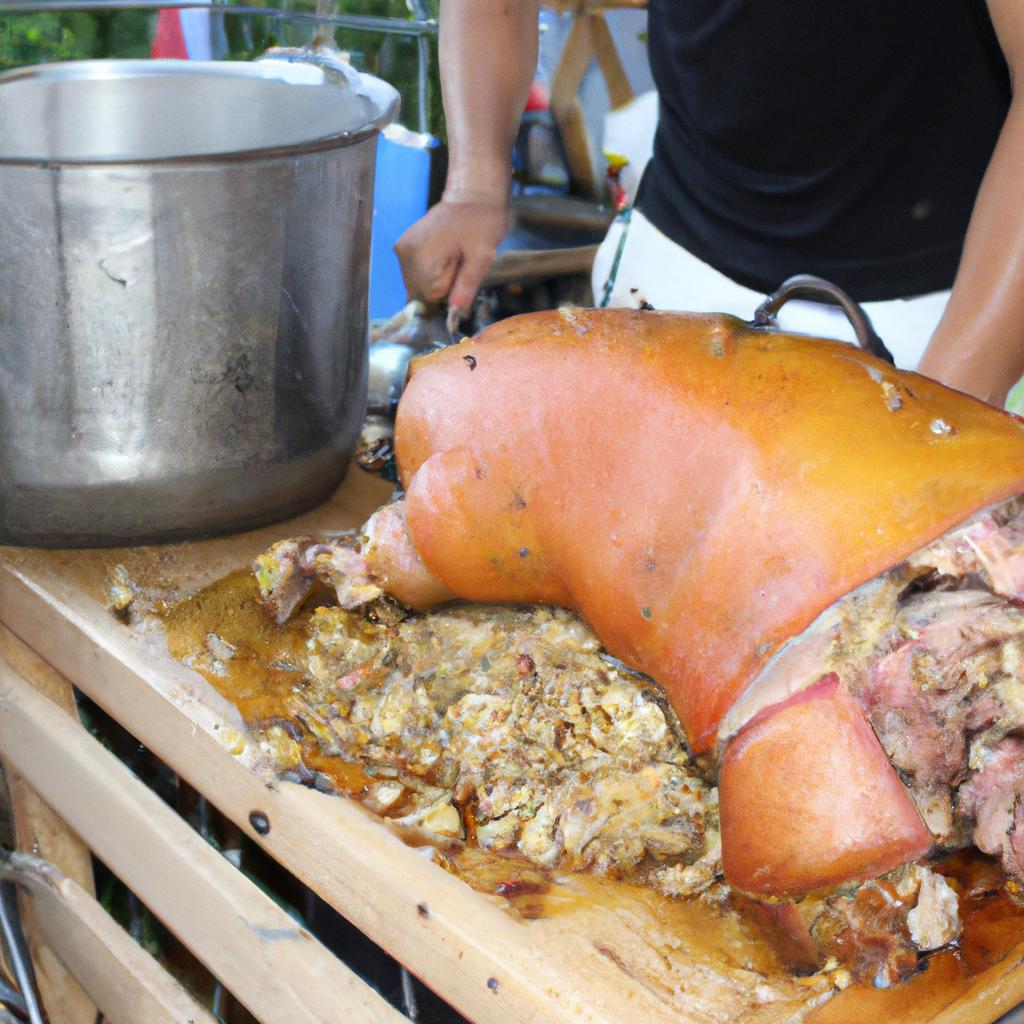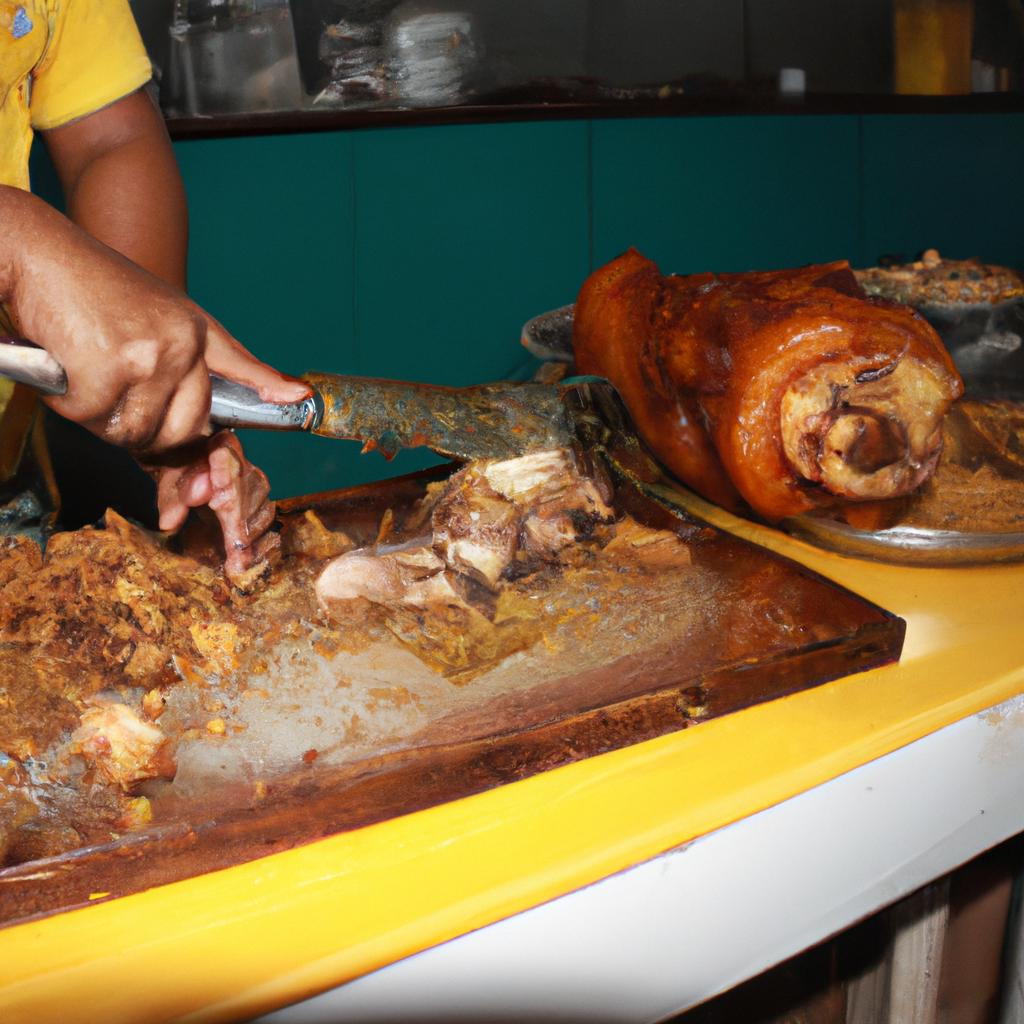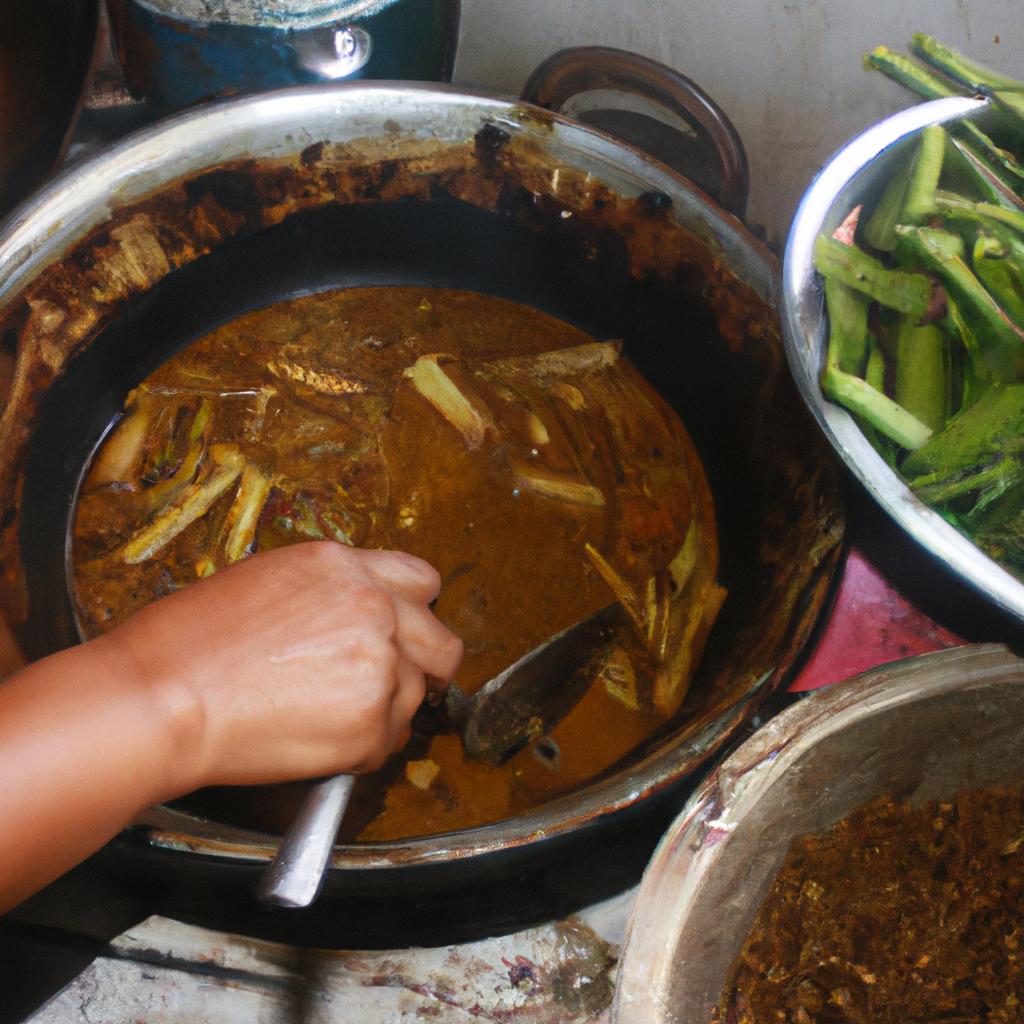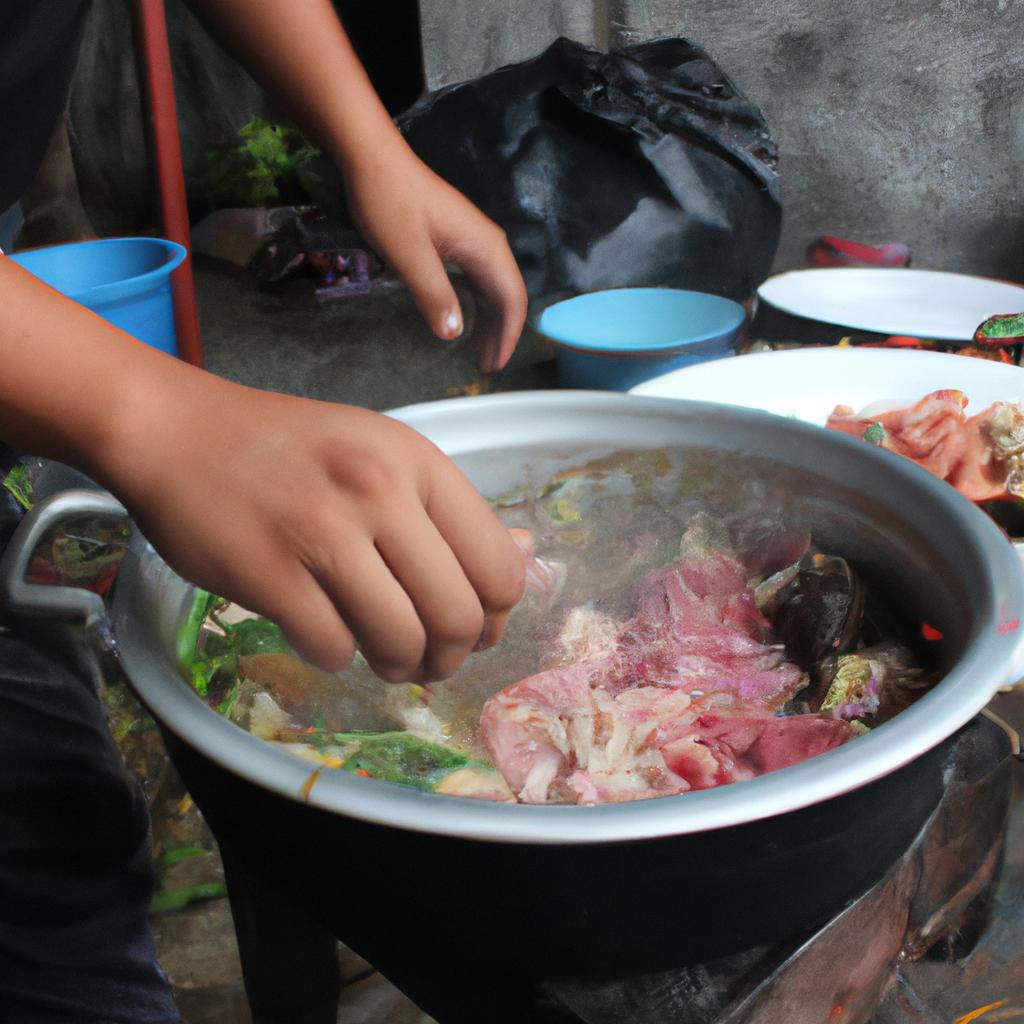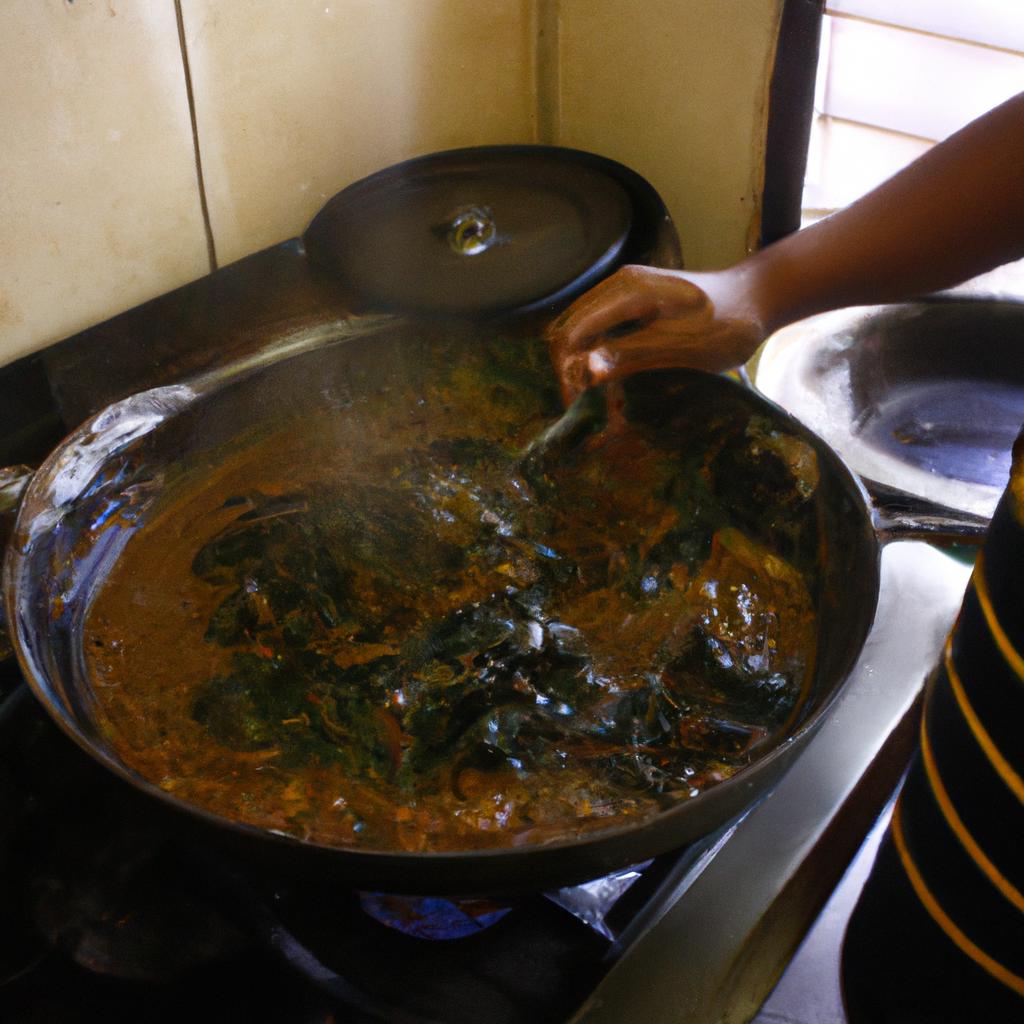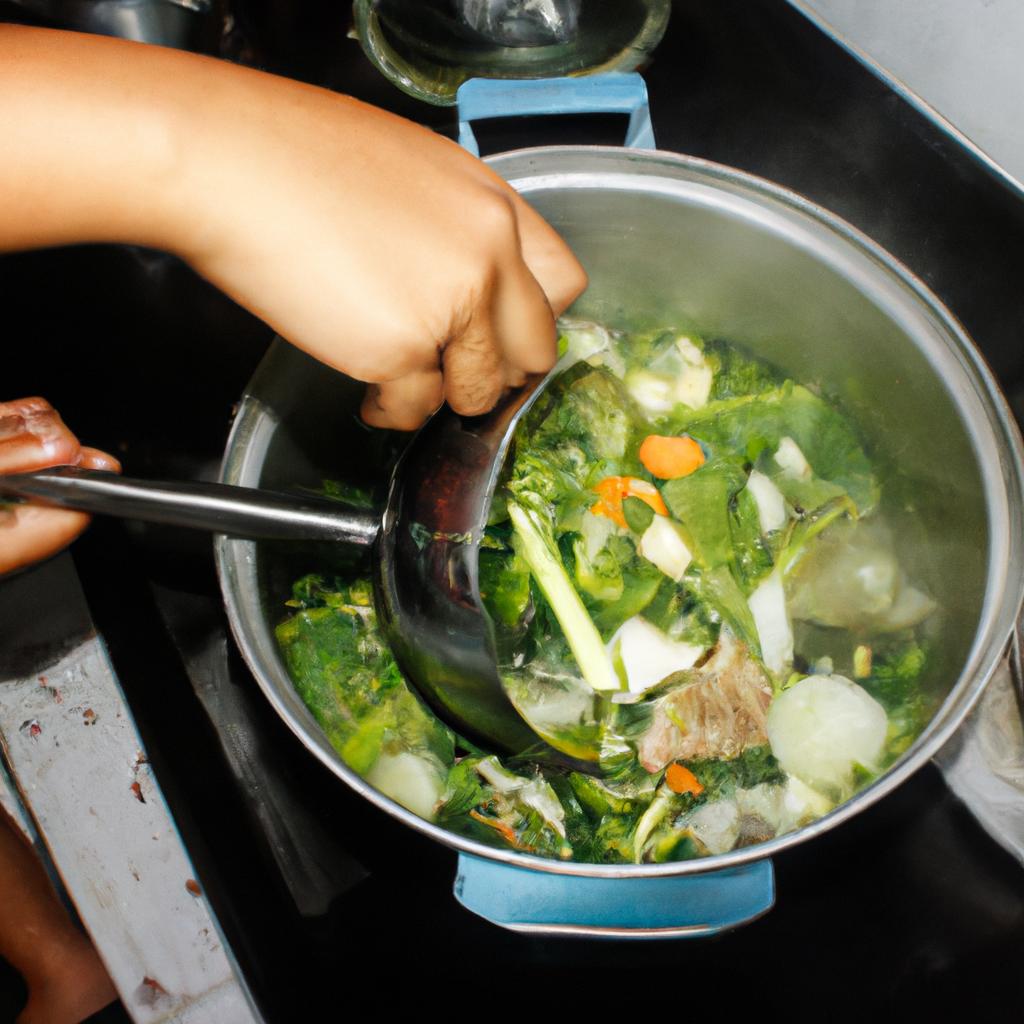The culinary world is a treasure trove of diverse and fascinating delicacies, each reflecting the unique cultural heritage of its origin. Among these delectable offerings, one that stands out in the vibrant tapestry of Filipino cuisine is lechon – a succulent roasted pig dish celebrated for its crispy skin and tender meat. With origins dating back to pre-colonial times, lechon has evolved into an iconic centerpiece of feasts and celebrations across the Philippines. This article aims to delve into the rich history, preparation techniques, and regional variations of lechon, shedding light on this beloved delicacy.
Imagine attending a grand fiesta in Cebu City, where the tantalizing aroma of roasting pork fills the air as street vendors proudly display their prized lechons. The sound of crackling skin entices passersby while locals eagerly line up with plates in hand, ready to indulge in this centuries-old tradition. Such scenes are not uncommon during festivals like Sinulog or Pasko sa Sugbo, where lechon takes center stage as a symbol of abundance and communal celebration. By examining the historical significance and cultural context surrounding this mouthwatering masterpiece, we can gain insights into how lechon has become deeply ingr ained in Filipino culture.
The origins of lechon can be traced back to the pre-colonial era, where it was a common cooking method among indigenous tribes. The term “lechon” itself is derived from the Spanish word for roasted suckling pig, reflecting the influence of Spanish colonization on Filipino cuisine. However, the tradition of roasting whole pigs existed in the Philippines long before the arrival of the Spaniards.
In traditional lechon preparation, a whole pig is carefully seasoned with a combination of spices and herbs, such as garlic, salt, pepper, and lemongrass. The pig is then skewered and slowly roasted over an open fire for several hours. The result is a crispy golden-brown skin encasing tender and flavorful meat. Achieving the perfect balance between crispy skin and moist meat requires skill and expertise, making lechon a true culinary art form.
While Cebu City is often hailed as the lechon capital of the Philippines, each region has its own unique take on this beloved dish. In Manila, for example, lechon is typically served with liver sauce or vinegar dipping sauce. In Ilocos Norte, they have their version called “bagnet,” which features extra crispy skin and succulent meat. Other regions may incorporate additional flavors and ingredients specific to their local cuisine.
Beyond its delicious taste and Cultural significance, lechon also holds economic importance in many communities across the Philippines. The production and sale of lechon provide livelihood opportunities for countless families involved in raising pigs, preparing seasonings, and operating small businesses centered around this delicacy.
In recent years, lechon has gained international recognition as well. Renowned chefs and food enthusiasts from around the world have praised its unique flavors and textures. It has even been featured in various culinary competitions and festivals globally.
As you explore Filipino cuisine or plan your next trip to the Philippines, make sure to indulge in the iconic lechon experience. Whether it’s savoring the crispy skin, enjoying the succulent meat, or appreciating the cultural heritage behind this dish, lechon promises a truly unforgettable gastronomic adventure.
Party Staple
‘Party Staple’
Imagine attending a lively Filipino celebration – the air filled with laughter, music, and mouthwatering aromas. Amongst the colorful array of dishes laid out on the table, one particular delicacy stands out: lechon. This roasted pig dish has become a staple at parties and special occasions in the Philippines, captivating both locals and foreigners alike. Its succulent meat, crispy skin, and flavorful seasonings make it an unforgettable centerpiece that leaves guests wanting more.
Lechon’s popularity as a party staple can be attributed to several key factors. Firstly, its impressive presentation instantly grabs attention and sets the stage for a memorable dining experience. The whole pig is carefully seasoned with a blend of herbs and spices before being slowly cooked over an open fire or rotisserie. As it rotates, the fat drips down onto charcoal below, creating an aromatic smoke that infuses every inch of the meat. Finally, when the time comes to serve, its golden-brown skin crackles under the knife revealing juicy layers of tender pork within.
To understand why lechon holds such significance in Filipino culture, let us delve into some reasons why this delectable dish evokes strong emotions:
- Tradition: Lechon has deep-rooted cultural ties in the Philippines dating back centuries. It is often associated with family gatherings and festive celebrations like birthdays, weddings, and fiestas.
- Community Bonding: The act of preparing lechon is seen as a communal effort that brings people together. Friends and relatives gather around while sharing stories and laughter as they prepare for hours-long cooking process.
- Indulgence: Eating lechon represents indulging in culinary pleasure—a momentary escape from daily routine allowing individuals to savor each bite without restraint.
- Nostalgia: For many Filipinos living abroad or those who have moved away from their hometowns, eating lechon triggers memories of their childhood and connects them to their cultural identity.
In summary, lechon has become an integral part of Filipino festivities due to its delectable taste, captivating presentation, and emotional significance. This culinary masterpiece has the power to evoke a sense of community bonding, nostalgia, indulgence, and tradition that transcends mere food appreciation. As we explore further into the world of Filipino delicacies, let us now step into the realm of “Lechon Manok,” another mouthwatering dish that holds its own unique place in Philippine cuisine.
Lechon Manok
Section: Lechon Manok
Lechon, the iconic Filipino delicacy known for its succulent flavors and crispy skin, has become a staple in parties and celebrations all across the Philippines. However, there is another variation of this mouthwatering dish that deserves equal recognition – lechon manok. Let us delve into the world of lechon manok and explore its unique qualities.
To illustrate the popularity of lechon manok, let’s consider a hypothetical scenario. Imagine it’s a festive holiday season, and families gather together to celebrate. Amongst the array of dishes on the table, one particular item stands out – a golden brown whole chicken perfectly roasted over an open fire. This is none other than lechon manok, capturing everyone’s attention with its tantalizing aroma and inviting appearance.
What sets lechon manok apart from its pork counterpart? Here are some key points to note:
- Healthier Option: Lechon manok offers a healthier alternative to traditional lechon as it uses chicken instead of pork. Chicken meat generally contains less fat compared to pork, making it an ideal choice for those who prefer lighter fare.
- Versatility: While traditional lechon often takes center stage during grand occasions, lechon manok can be enjoyed more frequently due to its smaller portion size. It is not uncommon to find street vendors selling individual servings of juicy lechon manok throughout various towns in the Philippines.
- Ease of Preparation: Unlike roasting an entire pig for hours on end, preparing lechon manok requires relatively less time and effort. The simplicity involved in seasoning and grilling a single chicken allows individuals or small businesses to easily reproduce this delectable dish at home or in local eateries.
- Affordability: In terms of cost-effectiveness, opting for lechon manok proves advantageous as it requires fewer ingredients and is generally priced lower than its pork counterpart. This makes it an accessible choice for individuals on a budget or those hosting smaller gatherings.
To further emphasize the appeal of lechon manok, consider the following table highlighting some key differences between traditional lechon and this delightful chicken variation:
| Aspect | Traditional Lechon | Lechon Manok |
|---|---|---|
| Meat Type | Pork | Chicken |
| Portion Size | Whole pig | Individual serving |
| Cooking Time | Several hours | Less time-consuming |
| Cost | Relatively expensive | More affordable |
In summary, lechon manok offers a healthier, versatile, easy-to-prepare, and affordable option to indulge in the flavorsome world of Filipino roasted meats. Now that we have explored this delectable variation of lechon, let us move on to another intriguing aspect – the crispy skin – which plays a vital role in enhancing the overall culinary experience.
Transitioning seamlessly into our next section discussing “Crispy Skin,” we will explore how this element contributes to the irresistible charm of both traditional lechon and lechon manok.
Crispy Skin
Lechon Manok, or roasted chicken, is a popular variation of the traditional Filipino dish known as lechon. While not as widely recognized as its pork counterpart, lechon manok holds its own in terms of flavor and succulence. To illustrate this point further, let’s consider the case of a family gathering where two dishes were served: lechon baboy (roasted pig) and lechon manok.
During the event, guests eagerly lined up to savor these delectable offerings. As they made their way through the buffet table, some opted for the classic choice of lechon baboy with its crispy skin and tender meat. Others decided to try something different and picked up a plateful of Lechon Manok instead.
What makes lechon manok unique is the distinct blend of flavors that permeates every bite. The chicken is marinated in a flavorful mixture before being slow-roasted over an open fire. This process allows the juices to infuse into the meat while giving it a slightly smoky aroma.
In addition to its mouthwatering taste, there are several reasons why lechon manok has gained popularity among Filipinos:
- Healthier Option: With its lower fat content compared to pork, lechon manok appeals to those looking for a healthier alternative without compromising on taste.
- Versatility: Lechon manok can be enjoyed on its own or paired with various sauces such as soy sauce, vinegar, or liver sauce.
- Convenience: Unlike larger cuts of meat like lechon baboy which require hours of preparation and cooking time, roasting a whole chicken takes less time and effort.
- Affordability: Compared to other types of roasted meats, such as beef or lamb, lechon manok tends to be more affordable while still providing an enjoyable dining experience.
To summarize, lechon manok offers a flavorful and versatile option for those seeking an alternative to the classic lechon baboy. Its unique blend of flavors, healthier attributes, convenience, and affordability make it an appealing choice for various occasions.
Traditional Roasting
Transitioning from the previous section, where we explored the tantalizing crispy skin of lechon, let us now delve into the traditional methods and techniques used in roasting this delectable Filipino delicacy.
Imagine a small town nestled in the heart of the Philippines. The aroma of roasted pig wafts through every corner as families gather for a festive occasion. In this picturesque setting, one can witness firsthand the age-old tradition of preparing lechon – a process that has been passed down through generations.
To ensure perfection in flavor and texture, several key factors contribute to the art of traditional roasting:
-
Selection of Pig: The chosen swine must possess certain characteristics such as tenderness, juiciness, and optimal fat distribution. These qualities are vital to achieving succulent meat while maintaining balance with the crispy exterior.
-
Marination Techniques: A variety of secret family recipes exist when it comes to marinating lechon. Typically, ingredients like garlic, onions, peppercorns, herbs, soy sauce or vinegar are combined to create an aromatic blend that penetrates deep into the meat fibers during hours of marination.
-
Spit-Roasting Method: The most iconic aspect of cooking lechon is its spit-roasting technique over an open fire pit. This slow-cooking method ensures even heat distribution while allowing excess fat to render out gradually. This results in tender meat on the inside and a delightfully crisp skin on the outside.
Intriguingly enough, these time-honored processes have not only contributed to satisfying palates but have also become emblematic symbols deeply intertwined with Filipino culture and heritage. As you savor each bite of lechon’s perfectly caramelized skin complemented by the succulent meat within, you are partaking in a culinary experience that reflects centuries of tradition and celebration.
Transitioning seamlessly into our next section on “Regional Variations,” let us now explore how different regions within the Philippines have infused their own unique flavors and techniques into this beloved dish.
Regional Variations
Continuing our exploration of the glorious tradition of lechon, let us now delve into the regional variations that have emerged across the diverse archipelago of the Philippines. To illustrate this point, let’s consider a hypothetical scenario where three individuals from different regions order lechon for a special gathering.
In Luzon, Maria decides to celebrate her daughter’s graduation by ordering a whole lechon from a renowned establishment in Manila. This version is known for its Crispy Skin and tender meat, achieved through meticulous preparation and slow roasting over charcoal. It embodies the classic flavors that have made lechon famous worldwide.
Meanwhile, in Visayas, Juanita organizes a family reunion on Cebu Island. She opts for their celebrated style of lechon called “Cebuchón.” What sets it apart is the use of various spices and herbs like garlic, onions, bay leaves, and tanglad (lemongrass). The result is an aromatic explosion of flavors that perfectly complements the succulent pork.
Lastly, in Mindanao, Abdul chooses to showcase his region’s unique take on lechon during Eid al-Fitr festivities. In this Muslim-majority area, they prepare “lechong manok,” which features a whole roasted chicken stuffed with traditional ingredients such as pandan leaves and ginger. Although slightly distinct from the usual pork-based versions found elsewhere in the country, it remains true to the spirit of communal feasting inspired by lechon.
To evoke a stronger emotional response towards these regional variations and celebrate their diversity further, here are four key aspects worth highlighting:
- A rich tapestry of flavors: Each region brings its own blend of spices and seasonings to elevate the taste of lechon.
- Cultural heritage and identity: The regional variations showcase the unique culinary traditions and cultural diversity found within the Philippines.
- Uniting communities: Lechon serves as a symbol of celebration, bringing families and friends together for joyous occasions.
- Culinary craftsmanship: The artistry involved in preparing lechon highlights the dedication and skill passed down through generations.
To provide a visual representation of these Regional Variations, here is a table showcasing some key characteristics:
| Region | Key Characteristics |
|---|---|
| Luzon | Crispy skin, tender meat |
| Visayas | Aromatic spices and herbs |
| Mindanao | Chicken-based variant with traditional stuffing |
As we can see from this exploration into the regional adaptations of lechon, its significance extends far beyond being just a delicious dish. It represents the richness of Filipino culture, unity among diverse communities, and showcases the creativity and craftsmanship that have made it an iconic delicacy.
Transition Sentence to ‘Lechon Festivals’: With such vibrant regional variations established, let us now turn our attention to the grand celebrations known as Lechon Festivals held across different parts of the Philippines.
Lechon Festivals
Transitioning from the exploration of lechon’s rich history, we now delve into the exciting realm of regional variations. To illustrate this diversity, let us take a closer look at one specific case study – the contrasting styles between Cebu and Manila.
In Cebu, lechon is renowned for its distinct flavors and preparation techniques. The pig is meticulously seasoned with a blend of spices that includes tanglad (lemongrass), siling labuyo (bird’s eye chili), garlic, and onion. This unique combination infuses the meat with an irresistible aroma and taste. Additionally, Cebuanos prefer roasting their lechon over charcoal pits to achieve a smoky flavor profile that perfectly complements the succulent meat within.
On the other hand, Manila showcases its own interpretation of lechon by focusing on achieving crispier skin through different methods. Instead of using whole pigs like in Cebu, Manileños often opt for smaller cuts such as pork belly or liempo. These portions are marinated overnight before being roasted in special ovens called “babahan.” The result is a tantalizing contrast between tender meat and crackling skin that draws enthusiasts from far and wide.
When exploring regional variations of lechon across the Philippines, several fascinating observations emerge:
- Each region has developed its own secret spice blends that impart distinctive flavors to their lechon.
- Different cooking techniques are employed, ranging from spit-roasting to oven-baking or even deep-frying.
- Local ingredients play a crucial role in creating unique taste profiles; coconut vinegar may be used in some regions while others rely on native herbs and spices.
- Presentation styles also differ significantly – from garnishing with fresh herbs to serving it alongside traditional condiments like toyomansi (soy sauce mixed with calamansi juice).
To further illustrate these regional differences, here is a table highlighting some key variations of lechon across the Philippines:
| Region | Main Ingredient | Flavor Profile | Cooking Technique |
|---|---|---|---|
| Cebu | Whole pig | Aromatic and smoky | Charcoal spit-roasting |
| Manila | Pork belly/liempo | Crispy skin, tender meat | Oven roasting (babahan) |
| Iloilo | Native chicken | Tangy with citrus notes | Spit-roasting |
| Pampanga | Suckling pig | Sweet and savory | Deep-frying |
With these regional variations in mind, it becomes evident that lechon not only unites Filipinos through their shared love for this delicacy but also showcases the diversity and creativity found within different culinary traditions across the nation.
As we move forward to explore the preparation process of lechon, let us uncover the meticulous steps involved in creating this mouthwatering masterpiece.
Preparation Process
Lechon, a traditional Filipino delicacy, has gained popularity not only in the Philippines but also internationally. In this section, we will delve into the intricate process of preparing lechon and explore its significance in Filipino culture.
Imagine yourself attending a grand feast where a whole pig is being roasted over an open fire. The tantalizing aroma fills the air as you witness the meticulous preparation that goes into making this mouth-watering dish. The first step involves cleaning the pig thoroughly and marinating it with a special blend of herbs and spices. The pig is then skewered on bamboo poles before being placed above hot coals for several hours until it reaches golden perfection.
To fully appreciate the artistry behind lechon preparation, let’s examine some key aspects:
-
Slow Roasting: One of the secrets to achieving succulent and flavorful lechon lies in slow roasting. This method ensures that every part of the pig is evenly cooked while maintaining its tenderness and juiciness.
-
Basting Technique: During the cooking process, lechon is continuously basted with a mixture of oil, soy sauce, vinegar, garlic, and various seasonings. This enhances the flavors and helps create a crispy skin that crackles when bitten into.
-
Stuffing Variations: While traditional stuffing often consists of aromatics like lemongrass, onions, and garlic, regional variations have emerged throughout the Philippines. Some regions opt for unconventional fillings such as pineapple or even rice stuffed inside the pig’s cavity.
-
Dipping Sauces: Lechon is typically served with a variety of dipping sauces to complement its rich taste. These may include spiced vinegar called “sawsawan,” liver-based sarsa (sauce), or sweet-sour combinations made from local fruits like mangoes or pineapples.
For an emotional response:
- Imagine sinking your teeth into tender meat encased in a crispy, golden skin.
- Picture the sight of families and friends gathered around a table, sharing laughter and stories as they enjoy this delectable dish.
- Consider the pride and joy felt by local communities during Lechon Festivals, where different regions showcase their unique variations of this beloved delicacy.
- Reflect on the cultural significance of lechon as it symbolizes abundance, celebration, and togetherness.
Through these hidden components, you’ll discover how each recipe holds its own charm and surprises for those fortunate enough to experience them.
Secret Ingredients
Section H2: Secret Ingredients
To truly understand the unique flavors of lechon, one must delve into its secret ingredients. While the preparation process sets the foundation for this Filipino delicacy, it is these hidden elements that add depth and complexity to every succulent bite.
Imagine a case where two chefs are given the same cut of pork belly to make their own versions of lechon. Chef A decides to use a combination of garlic, salt, and pepper as his primary seasonings. Meanwhile, Chef B takes a different approach by incorporating unconventional ingredients such as lemongrass, star anise, and even a hint of coconut milk. The end results showcase how these secret ingredients can elevate the taste profile of lechon in distinct ways.
- The addition of tanglad (lemongrass) imparts a subtle citrusy aroma that complements the richness of the roasted pig.
- Star anise provides a warm and slightly licorice-like flavor that enhances the overall savoriness.
- Coconut milk adds creaminess and helps tenderize the meat while infusing it with delicate hints of tropical sweetness.
- Other lesser-known spices like pandan leaves or tamarind pulp may be used to create additional layers of flavor.
In order to fully grasp how these secret ingredients come together harmoniously in lechon recipes, let us explore them in more detail through this table:
| Secret Ingredient | Flavor Profile | Function |
|---|---|---|
| Lemongrass | Citrusy, aromatic | Complements rich roasted pork |
| Star Anise | Warm, slightly licorice-like | Enhances savoriness |
| Coconut Milk | Creamy, subtly sweet | Tenderizes and adds sweetness |
| Pandan Leaves | Fragrant, grassy | Adds complexity to the flavor |
As we can see, these secret ingredients not only contribute unique flavors but also serve specific purposes in enhancing the taste and texture of lechon. Through careful experimentation and personal preferences, each chef may incorporate their own variations of these elements.
Transitioning into our next section on “Serving Suggestions,” it is important to note that while understanding the secret ingredients is key to appreciating the intricacies of lechon, there are still various ways to showcase and enjoy this Filipino delicacy beyond its preparation process.
Serving Suggestions
Lechon, a famous Filipino delicacy known for its succulent and crispy skin, is not just about secret ingredients; it also involves unique techniques that contribute to its delectable taste. Let’s delve deeper into the art of preparing this mouthwatering dish.
One technique used in lechon preparation is called “inihaw sa kawayan.” Traditionally, the whole pig is skewered on bamboo sticks and roasted over an open fire. This method imparts a distinct smoky flavor to the meat while ensuring even cooking. The slow rotation of the spit allows the fat to render slowly, resulting in tender and juicy meat with a crisp exterior.
Another technique employed by lechon connoisseurs is basting or brushing the pig with various marinades throughout the roasting process. These marinades typically consist of soy sauce, calamansi juice (a local citrus fruit), garlic, and other spices. Basting helps infuse flavors into the meat while adding moisture and enhancing its aroma.
To achieve that perfect crunchiness in lechon’s skin, cooks apply a layer of salt or vinegar before roasting. This step aids in drawing out excess moisture from the skin while facilitating better heat distribution during cooking. As a result, you get an irresistible crackling texture that contrasts beautifully with the tender meat beneath.
- The tantalizing aroma of slowly-roasted pork fills the air.
- The sound of sizzling fat as it drips onto hot coals creates anticipation.
- The visual appeal of golden-brown skin glistening under sunlight entices one’s appetite.
- The joyous celebration where friends and family gather around to share this sumptuous feast enhances feelings of togetherness and happiness.
| Aroma | Sound | Visual Appeal | Social Connection |
|---|---|---|---|
| Smoky | Sizzling | Golden-brown skin | Celebration with loved ones |
| Glistening under sunlight |
In unraveling the techniques behind lechon, we discover a gastronomic experience that involves not only secret ingredients but also meticulous cooking methods. The combination of inihaw sa kawayan, basting, and strategic pre-roasting steps results in a culinary masterpiece that delights all senses. Now, let’s explore the health benefits associated with this beloved Filipino dish.
As we unveil the secrets of lechon’s preparation techniques, it is important to consider its impact on our well-being. Let us now dive into the health benefits that can be derived from consuming this flavorful delicacy.
Health Benefits
Transitioning seamlessly from the previous section on serving suggestions, let us now delve into the health benefits of indulging in this delectable dish. To illustrate its impact, consider the hypothetical case of Maria, a health-conscious individual who was initially hesitant about trying lechon due to concerns regarding its nutritional value.
First and foremost, it is worth noting that moderation is key when embracing any cuisine. While lechon may not be touted as an everyday option for those following strict dietary guidelines, it does offer certain advantages when enjoyed occasionally. Let us explore some of these benefits:
- Rich source of protein: Lechon provides a substantial amount of protein, which plays a vital role in muscle growth and repair.
- Essential vitamins and minerals: This Filipino delicacy contains various essential nutrients such as iron, zinc, vitamin B12, and selenium.
- Flavorful alternative to processed meats: Opting for freshly prepared lechon instead of processed meat products can be a healthier choice due to reduced additives and preservatives.
- Cultural significance: Indulging in traditional dishes like lechon fosters a sense of cultural identity and pride.
In addition to these points, we can observe the potential health benefits through a comparative analysis using the following table:
| Health Benefit | Lechon | Processed Meat | Fresh Grilled Chicken |
|---|---|---|---|
| Protein Content | High | Moderate | High |
| Vitamin B12 | Present | Present | Present |
| Iron | Moderate | Low | Low |
| Additives | Minimal/None | High | None |
As evident from this comparison, while lechon may contain slightly higher levels of fat, it also boasts a significantly better nutritional profile compared to processed meats. It is crucial to keep in mind that individual dietary needs and preferences should dictate the inclusion of lechon or any other food option.
Transitioning smoothly into our next section on cultural significance, we can see how lechon transcends its status as merely a dish and becomes an integral part of Filipino tradition and heritage. Through continued exploration, we will uncover the roots of this culinary masterpiece and understand its broader impact on Philippine culture.
Now let us explore the profound cultural significance surrounding lechon without delay.
Cultural Significance
Section: Nutritional Content
Transitioning from the previous section on the health benefits of Lechon, it is important to delve into its nutritional content. By examining the composition of this Filipino delicacy, we can further understand its impact on our overall well-being.
To illustrate the nutritional aspects of Lechon, let us consider a hypothetical case study involving two individuals following different dietary preferences. Jane adheres to a low-fat diet while Mark follows a high-protein diet. Both are served equal portions of Lechon during a festive gathering.
Examining the nutritional profile reveals that Lechon offers several healthful components:
- High protein content: A single serving of Lechon provides an ample amount of protein, which is essential for muscle repair and growth.
- Good source of vitamins and minerals: Despite being primarily meat-based, Lechon contains various vitamins and minerals necessary for bodily functions such as iron, zinc, vitamin B12, and niacin.
- Moderate calorie density: While it is true that Lechon has higher caloric content compared to some other dishes, portion control allows individuals to enjoy it within their daily energy requirements.
- Flavorful fats: Although known for its crispy skin rich in fat content, certain types of fats found in Lechon can contribute positively to heart health when consumed in moderation.
Considering these factors alongside individual dietary needs and goals enables people like Jane and Mark to make informed decisions about incorporating Lechon into their meals.
The aroma wafting through the air as
you walk by a street food stall,
the sizzle heard as succulent
Lechon is roasted over open flames,
the anticipation felt as you watch
the golden-brown skin crackling,
and finally, the satisfaction experienced
when sinking your teeth into tender meat.
Furthermore, presenting information visually through a table can evoke an emotional response:
| Nutritional Content of Lechon | Amount per serving |
|---|---|
| Protein | 20g |
| Iron | 2mg |
| Zinc | 1.5mg |
| Vitamin B12 | 0.8mcg |
Emphasizing the nutritional value of Lechon is crucial in highlighting its potential benefits, allowing individuals to make well-informed decisions about including it as part of a balanced diet.
Transitioning into the subsequent section on “Lechon’s Global Recognition,” we acknowledge how this beloved delicacy has transcended boundaries and captivated taste buds worldwide.
Lechon’s Global Recognition
Following the exploration of lechon’s cultural significance, it is evident that this Filipino delicacy has not only captivated local palates but has also gained global recognition. One intriguing example is the case of Anthony Bourdain, a renowned American chef and television personality who was enchanted by lechon during his visit to the Philippines.
Lechon’s journey towards international acclaim can be attributed to several factors. Firstly, its distinct flavor profile sets it apart from other roasted meats around the world. The combination of succulent meat infused with aromatic spices creates an unparalleled taste experience that appeals to diverse culinary preferences. Moreover, lechon showcases the skillful craftsmanship involved in its preparation – from selecting high-quality ingredients to meticulously slow-roasting the whole pig over open flames for hours on end.
To further illustrate the widespread appreciation for lechon, let us consider four key reasons why people worldwide have embraced this Filipino dish:
- Flavor explosion: Lechon tantalizes taste buds with its crispy skin offering a delightful contrast to tender and juicy meat.
- Social centerpiece: In many cultures, sharing food brings people together. Lechon’s large size makes it a perfect centerpiece for festive gatherings and celebrations.
- Cultural immersion: Trying lechon allows individuals to immerse themselves in Filipino culture and gain a deeper understanding of their traditions and customs.
- Memorable experience: Indulging in lechon leaves an indelible mark on one’s gastronomic repertoire; it becomes more than just a meal but rather an unforgettable experience.
In addition to these reasons, we can observe how lechon’s popularity has transcended borders through its presence in various parts of the globe. The table below illustrates some notable destinations where this beloved dish has made its mark:
| Country | City | Popular Lechon Variants |
|---|---|---|
| Philippines | Cebu | Cebu lechon |
| Puerto Rico | Guavate | Lechón asado |
| Spain | Segovia | Cochinillo |
| United States | Los Angeles | Filipino-style lechon |
Through its global recognition, lechon has become a cultural ambassador for the Philippines. Its ability to transcend borders and captivate taste buds worldwide reaffirms this delicacy’s place in culinary history. As more individuals discover and savor the unique flavors of lechon, its influence continues to grow, solidifying its position as an iconic dish celebrated across continents.


